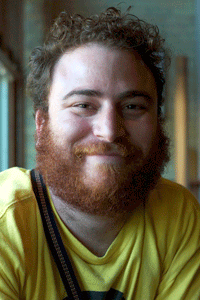Tools for Discovery is a monthly profile series that inspects the computer programs, gadgets and methods behind WID’s ideas and discoveries.
Former WID postdoctoral researcher Ben Shapiro is an assistant professor in computer science and education at Tufts University.

What do you work on as a member of the WID community?
When I was at WID, I was a postdoc in the Games+Learning+Society group and also spent a lot of time working with Michael Ferris with the Optimization group. I was working on a couple game design projects that were about enabling learners to learn about interesting domains of science by participating in them virtually. And by participating in that case, what I mean is being able to role-play as the kinds of people who are involved in those kinds of science.
For the game Trails Forward, we wanted to give people an opportunity both to experience the viewpoints of different stakeholders in rural Wisconsin ecology and economics, to understand what conflicts can arise between those perspectives and understand what the ecological ramifications of those conflicts can be. So in that case, people could play as a logger or a housing developer or an environmental non-profit, and as you make choices about the landscape, you sort of see the carry-on effects of that on different species as well as on the economy of the area.
What about now at Tufts University?
I’m up to two things right now: One is trying to finish up a nicely playable version of the Trails Forward game and the other deals with working on a toolkit so that kids can create their own networked devices. So you know, lots and lots and lots of teens use social media of various sorts, from Twitter and Instagram to Facebook and other sites, and it’s something that they’re really passionate about. At the same time, they connect through all sorts of devices, from phones and laptops to Xbox and Fitbits and there’s really little out there in terms of computer science education that really connects to those kinds of interests. Networks and distributed systems are generally treated as something that comes pretty late in the curriculum, and we think it doesn’t have to be. So what we’ve been working on is a toolkit called BlockyTalky that makes it really easy for kids to build their own physical devices that are connected to the Internet and can both interact with other devices as well as tap into social media.
What are your tools for analysis?
Most of the work that we do is pretty qualitative, so we’re not interested in the kind of evaluation work that you see a lot of people doing in bad educational research. People go out and they say, “Hey, we did this thing and the kids are 5 percent more interested in being a scientist when they’re done,” or “Hey, kids did 5 percent better on a test.” Or maybe in the rigorous cases, they’re 5 percent better at a test compared to how they do when they go through this other experience. And that’s sort of OK to have these correlational results, but they don’t really tell us a lot about how people learn and they don’t really tell us very much about how people don’t learn. They don’t tell you about who’s engaged and who’s not and how and why — how they’re thinking about this stuff.
And it’s really hard to get at those sorts of things through methods other than being there and watching and interviewing and looking at the kinds of things students are making. So a lot of the work we do is around that. So for example, in the case of the networked stuff, I really want to understand how kids think about what a network is and how a network behaves and what does it mean for the kinds of problems that they’d like to solve.
“I think trying to understand how the work we do can empower people to understand and transform the world around them is sort of the thing that I’m after.”
— Ben Shapiro
Now that said, there is work we are also doing that is trying to quantify and analyze it statistically. One of the things we’re interested in is how do we create environments that nurture children’s creativity and lead them to be producing interesting novel things that are different than something someone else has made before. And so we would say upfront if you’ve got two learning environments and one is one where all the kids produce the same thing and another is one in which they all produce different things, and those different things are different solutions to a problem, we’d favor the latter one, because we believe those are the kinds of environments where kids are actually being creative and expressing ideas, much more than one where they’re going down a funnel into making the same thing. So we’re trying to develop quantitative measures for knowing when that happens.
Tools for writing?
I use LaTeX, Git, and paper. I have mounds and mounds of paper, and three shelves of notebooks. I do a lot of writing by hand, especially if I’m writing by myself. Then, I’ll typically edit while I type it up. If I’m writing with other people, I’ll use Google Docs or Share LaTeX. And I don’t know, I guess I’m not very high-tech in that way.
When I’m writing with people in LaTeX, I can write a bunch of text and comment it out as sort of a thought that’s incomplete or, maybe someone should think about too. You can’t really do that with Microsoft Word.
Tools for collaboration?
Git and Dropbox are near and dear to my heart. Lately I’ve been using Share LaTeX, but I’m interested in other sorts of collaborative writing tools. Also air and physical spaces. A lot of time you don’t need something high-tech, you just need to get together and close the door, shut your laptop and talk to each other.
So, I don’t know, for my tools for collaboration… vibrating air and ink on whiteboards? Oh, and video chats, because I have collaborators who are far away.
Your ultimate tool for discovery?
Compassion, I think.
I think trying to understand how the work we do can empower people to understand and transform the world around them is sort of the thing that I’m after, and I think computation is a really powerful way to be able to do that. You know, one thing that I tell any student who wants to come work with me is, “If you are excited about having your own research project, you’ve come to the wrong lab,” because nobody works alone here, and I will not let students have their own project. There has to be at least two working together. And they can certainly have pieces of it that they are emphasizing their attention to or extra concentrating on, but nobody gets to have “my thing” and “your thing” because I don’t think people learn particularly well that way.
And also, the subject of our work is almost exclusively — in fact, I can’t think of any exceptions — about collaborative learning environments. I think it would be weird to not practice what we preach.


You must be logged in to post a comment.